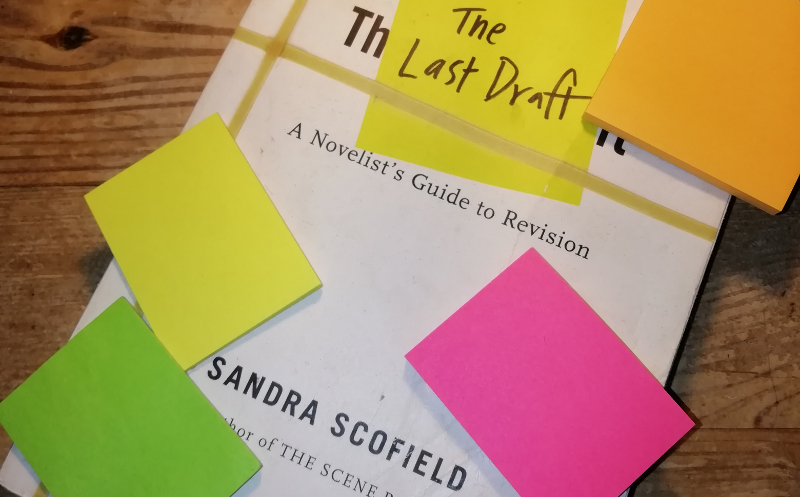
How do you get from a sloppy first (or second or third) draft to something approaching a publishable manuscript?
I’ve been a fan of The Scene Book by Sandra Scofield for years (in fact I created an exercise based on it which I use all the time). So I was excited to come across The Last Draft. A Novelist’s Guide to Revision. All the more so as I surveyed the state of my latest big fat messy novel draft.
I’m an inveterate creator of scrappy drafts. And I have spent plenty of time on quests to finish the job, too. One problem I often face is a terrible baking in. The tendency for the structure of my initial work to become ossified over time so that no amount of finesse at the sentence level can ever address the project’s underlying problems — that the thread of my story is convoluted, my characters’ motivations weak, the stakes insufficiently high. There’s no point polishing a — well, something fundamentally unappetising — but that’s just what I do. I churn out draft after draft of increasingly slick prose, draped over bones that will never carry a story. This book offers strategies which encourage writers to analyse, break and reset the structure of their work — to define a vision and redraft according to its force.
Scofield’s approach to the problem breaks down, at heart, into roughly three stages.
- Define your novel in essence and summary — describe its themes and major plot points.
- Assess what you have, working through your draft chapter by chapter.
- Plan, reorganise and rework.
Although these steps might seem strictly consecutive, the reality is a little more complex than that. That’s not a problem with the book so much as an issue intrinsic to the redrafting process. In defining your novel, you distill the work you have done. And yet, at the same time, you are working towards a sharper, deeper, clearer vision. That means, as you revise, your overview takes on an uneasy dual status — it describes both what your work currently amounts to and what it should be. Scofield’s book embraces this dynamic.
If you feel drawn to make some changes in the story, the summary is a good place to test them. Don’t feel chained to your draft; you have begun the steps that take you to a revision. Or you might write a summary of what you hve, print it out, then annotate it with questions and comments in the margins…
Think of yourself as building a dossier, a kind of case study of the story you are looking for. Keep writing new summaries.
A novel, by its nature, is often big and unwieldy — prosaic in fact. This extract reflects a great strength of The Last Draft — it encourages the author to render a novel draft’s essentials. In working with those essentials — summaries, key scenes, chapter overviews, threads, others — you can begin to hold the gelatinous mass of the whole in your head, to move its parts around.
The creative tension between assessment and planning in The Last Draft also raises a possibility that speaks to the endless battle between the plotters and organic writers. Much work that is presented here in relation to an existing draft could be applied to the upfront planning process.
Some Take Aways
In this section I distill some useful elements that you might use right away. Remember, though, that this is not a substitute for the book itself.
Overview
A high level understanding of the state of your novel — partly as it now is, but mainly, and increasingly, as it should be.
- Create a summary of your novel — no more than a page or two. Is it big enough? Can you deepen it? Rework the summary until it has the shape and depth to justify an entire novel.
- Sum up the novel in a sentence.
- Define the novel’s action (what happens) and intent (the emotional drive) in a paragraph.
- Distill this into a vision or intent — a single sentence
- Describe the world of the novel
- Describe the timeline (initially without reference to the manuscript) — both foreground and background
- Describe your protagonist — does he or she have enough agency (a passive protagonist is a problem)
- Examine the ending of the novel. Does it fulfil the promise established by premise? Is it both surprising and inevitable.
- Describe major characters. Are they necessary to the story? Can/should any be cut or combined.
Assessment
A much closer reading. By definition, this assessment focusses on the draft you have written, but you should annotate with a view to what you want to achieve. You’ll be using this work in the planning phase. When I went through this stage, I filled out Post-It notes for distinct aspects I wanted to track across my reading and added them to the start of each chapter in my print out.
- Examine point of view.
- Create a tagline for every chapter.
- Delve into six key scenes across the novel. Analyse them deeply, looking at the balance of backstory, present action, summary and exposition. How do the scenes flow from one to the next?
You are putting a dipstick into your manuscript; you want to see if the same fluid is running under all its pages.
- Delve deeper into two of the scenes, breaking them down. You’re looking for purpose, dramatic impact, flow, clarity, build of action, setting and viewpoint.
Planning
In this phase you bring together your initial summary of your novel and your assessment of your draft and use them to forge a bullet proof plan for the novel. Create a new summary of the plot focussing on the story problem, the crisis point and the resolution. In more detail chart the beginning, middle and end of the novel. Does the beginning establish a deep story question, offer an effective catalyst? Does the middle offer complications and a moment of impossibility. Is the promise of the beginning answered by the resolution — is it both surprising and inevitable?
- Examine the protagonist and his or her journey. How does it fulfil the vision of the novel? How does the she or he change?
- Define six to ten key scenes — the backbone of the novel. Track the progression of the story through them. Are they all essential to the novel — are the doing the work they should?
- Track ‘threads’ through the story. These may seem analogous to subplots but it goes deeper and wider than that, a thread may also be thematic or emotional.
- Bring this work to bear on your assessment of the first draft — what scenes and chapters are you going to keep. Of those you are keeping which need to be rewritten or tightened?




